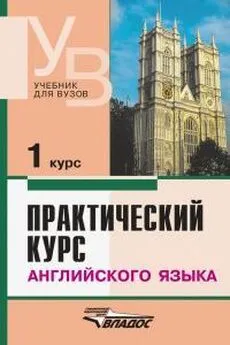Владимир Аракин - Практический курс английского языка 1 курс
- Название:Практический курс английского языка 1 курс
- Автор:
- Жанр:
- Издательство:ВЛАДОС
- Год:1998
- ISBN:нет данных
- Рейтинг:
- Избранное:Добавить в избранное
-
Отзывы:
-
Ваша оценка:
Владимир Аракин - Практический курс английского языка 1 курс краткое содержание
I - V курсов педагогических вузов.
Цель учебника – обучение устной речи на основе развития необходимых автоматизированных речевых навыков, развитие техники чтения, а также навыков письменной речи.
Практический курс английского языка 1 курс - читать онлайн бесплатно полную версию (весь текст целиком)
Интервал:
Закладка:
The flat is not large but it is comfortable. In it there are two rooms, a kitchen,
a bathroom, a lavatory and a small hall.
The sitting-room is through the door on the left. There is a piano in it. There
is a picture on the wall over the piano. It is a still-life. In the picture there is a
silver tea-pot, a silver dish with three oranges in it, and a vase of red roses. The
picture is by a famous woman artist. The sofa is by the wall opposite the door. It
is of a rich red colour. There is a small round table in front of the sofa. There are
two modern armchairs on both sides of. the large window. On the window there
are curtains of a very pretty colour. There is not a sideboard in this room, but
there is one in the kitchen.
The bedroom is not large. It is square. The walls are light pink. There is a
silvery grey carpet on the floor. The effect is very fine. There are two beds here
with bedside tables beside them. In the right-hand corner near the window there
is a dressing table with a large looking-glass and a round stool in front of it.
There are not many things*in the rooms.
16. "* This exercise is meant to develop your ability to hear and reproduce
intonation in proper speech situations, a) Listen to the dialogue sentence by sentence.
Mark the stresses and tunes. Practise the dialogue, b) Record the dialogue and listen to
your recording to detect the possible errors. Memorize the dialogue and dramatize it:
Afternoon Tea
"Good afternoon, Mrs. White, how are you?"
"Very well indeed, thank you, and how are you?"
"Quite well, thank you. Won't you sit down. Excuse me, please. I think that's
my niece at the door."
"Hallo, Betty, dear! I'm so cflad to see you. You do look well. I don't think
you've met each other before. Let me introduce you. This is my niece, Miss
Smith. Mrs. White, Mr. White."
"How do you do."
"How do you do."
"And now let's have some tea. How do you like your tea, Mrs. White, strong
or weak?"
"Not too strong, please, and one lump of sugar. I like my tea rather sweet, but
my husband prefers his without sugar."
"Well, what's the news, Mr. White? How's business?"
"Pretty good, thank you. And how are things with you ? "
"Well, not too good, I'm afraid, and going from bad to worse, [n fact, it'^ the
worst year we've had for a long time."
"I'm sorry to hear that. I hope things will soon improve."
"Yes, let's hope for the best. And how's your nephew Richard getting on?"
"Oh, he's getting on quite well, thank you. He's staying in :he country just
now with his Uncle William and his cousins."
"How long is he going to stay there?"
"I don't know exactly, but he's having a very pleasant time and it's doing him
a lot of good, so the longer he stays, the bet-:er."
c) Give a conversational context in which the following phrases co-jld be used:
1. Hello, Betty, dear! I'm so glad to meet you. 2. How do you do. 3. How are
you? 4. Quite well, thank you. 5. Pretty good, :hank you. 6. Excuse me, please. 7.
I'm so glad to see you. 3. Oh, he's getting on quite well, thank you. 9. Not too
good, I'm afraid. 10. Well, what's the news, (Tom)? 11. How are things (with
you) ? 12. No more, thank you. 13. I'm sorry to hear that.
17/** Read the dialogues. Mark the stresses and tunes. It is not expected that each
memberof the group will intone the dialogues in exactly the same way. Practise reading
your corrected variant:
"Hello, John, I'm so glad you've come. How are you?" "Quite well, thank
you. How are you?" "Very well indeed, thank you. Have you met Mr. and Mrs.
Black? They are staying with us for the week-end." "Oh, yes, we know each
other quite well." "That's good. And now this is Mary with the tea, I think.
Yes, it is. Thank you, Mary. John, you can pass the tea round Do you have
sugar in your tea, Mrs. Black?"
"Just a little, please, but no milk."
"Any sugar for you, Mr. Black?"
"Yes, please, I like a lot of sugar."
"Most of men do, I think. My husband likes his tea very sweet."
"And what will you have with it, a sandwich, or one of these cakes?"
"A sandwich, please."
"How is your mother, Mrs. Black? I hear she's not been very well."
"No, she hasn't, but she's much better now. She's staying with my brother for
a few days and then she's coming to stay with us."
"I'm glad to hear she's getting better."
18.
Make up a conversation with the phrases from the dialogue "Afternoon Tea".
18. This exercise is meant to develop your ability to read and narrate a story with proper
intonation, a) Listen to the joke. Write it down. Mark the stresses and tunes. Practise reading
the joke, b) Listen carefully to the narration of the joke. Observe the peculiarities in
intonation-group division, pitch, stress and tempo. Note the use of the temporisers. Retell the
joke according to the model you have listened to.
19. Read the joke silently to make sure you understand each sentence. Find the most
important sentence in the text. Underline the main word in each sentence. Sptit up each
sentence into intonation-groups, mark the stresses and tunes. Practise reading the joke. Make
your reading expressive. Retell the joke according to the model (see Ex. 19):
Two Americans were travelling in Spain. Once they came into a little
restaurant for lunch. They didn't know Spanish and the waiter didn't know
English. In order to make him understand they wanted some milk and
sandwiches they drew a cow. The waiter looked at it and ran out of the
restaurant. Soon he was back and put down in front of the two men two tickets
for a bullfight.
Section Seven>
Intonation Pattern VI
(LOW PRE-HEAD + ) FALL RISE ( + TAIL)
M o d e l : Do you often go to the theatre?
^Some/times. "^^/
Of ^course, I ,do. 9 J
__________________.______________________I
Stress-and-tone marks in the text: Fall-Rise: | v | \ /1 \ ,. /|
t
e.g. \/Yes. vGeneral,ly. Well J don't ,think so.
This intonation pattern is used: s I n s t a t e m e n t s expressing concern,
reproach, contradiction, correction, hurt feelings, sometimes soothing.
The Fall-Rise is also used in non-final intonation-groups or in sentences of
different communicative types instead of the low-rising nuclear tone to draw
particular attention to one of the words for the purpose of contrast or to intensify
the significance of the communicative centre.
е. д. I wish we'd left earlier. — That wasn't xmy, fault. It's so hot in this room.
— VIdon't,think so. You'll be thirty-five soon. — Thirty \/four. Is it going to rain?
I
—
vhope ,not. Do you work every day? — On vweek ,days | Ivwork, |
but on vSun,days 11 xdon't.
FALL-RISE SPREAD OVER TWO SYLLABLES
M o d e l : v Sometimes.
The fall of the voice starts from a fairly high or medium pitch and usually
ends rather low. The rise begins very low and does not go up too high.
EXERCISES
1. a)* Listen carefully to the following conversational situations. Concentrate your
attention on the intonation of the replies:
Verbal Context Drill
I thought they all took one. Didn't Smith and Jones go? Can Jack and Bill
come to tea? Have Bob and Jane arrived? Hike oysters.
I've passed my driving test. I don't think she's at all nice.
S t a t e m e n t s
(expressing concern, hurt feelings, reproach,
contradiction, corrections, contrast)
Ann did. Smith went. Bill can. Jane's here. You may. That's good. I do.
John does. Tim does.
I suppose you're working all the time. On week days.
Must I go by train?
You don't have to.
b) Listen to the replies and repeat them in the intervals. Make your voice fall as low
as possible on the nuclear syllable. Start the rise from the lowest pitch and do not go up
too high. Do not accent the tail, c) Listen to the verbal context and reply in the interval.
FALL-RISE SPREAD OVER A NUMBER OF SYLLABLES
M o d e l : vHe can / manage it. t___________________. •
In this case the fall is on the stressed syllable and the rise is separated from
the fall by one or more syllables. The syllables between the fall and the rise are
always on a very low level.
EXERCISES
2. a)* Listen carefully to the following conversational situations. Con rentrate your
attention on the intonation of the replies:
Verbal Context
Drill
S t a t e m e n t s
(expressing concern, hurt feelings, reproach,
Can you play chess? I think they'd Л contradiction, correction, contrast)
agree. Have you finished? But you
Once I could. Stephen would. Practically. Usually
aren't free on Sundays. So you all
I am not. I didn't think he was. You couldn't help it.
thought him guilty. I'm sorry about the He won't know what's happened.
Читать дальшеИнтервал:
Закладка:





![Владимир Аракин - Практический курс английского языка 3 курс [calibre 2.43.0]](/books/1072035/vladimir-arakin-prakticheskij-kurs-anglijskogo-yazyk.webp)




